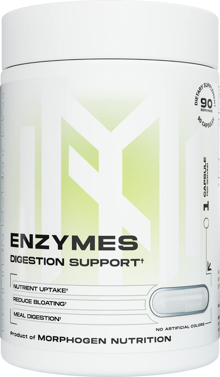
Morphogen Nutrition ENZYMES - Digestion Support
Go to Store
Morphogen Nutrition ENZYMES - Digestion Support
Go to StoreENZYMES: DIGESTION SUPPORT
Nutrient Uptake • Reduce Bloating • Meal Digestion
ENZYMES is a full-spectrum digestive enzyme blend that helps you break down protein, carbs, fats, and fiber for improved nutrient absorption and post-meal comfort. Featuring DigeSEB Super, this convenient capsule formula can be taken with meals daily to support smoother digestion, reduced bloating, and enhanced gut function whether you’re bulking, cutting, or just eating clean.
Key Benefits:
Supports efficient digestion of all macronutrients
Reduces bloating, gas, and digestive discomfort
Enhances nutrient breakdown and uptake
Perfect for high-protein or high-volume diets
DigeSEB Super Enzyme Blend – 300 mg
A comprehensive digestive enzyme complex designed to support macronutrient and fiber breakdown across a broad pH range. Includes:
Amylase
An enzyme that breaks down starches (polysaccharides) into simple sugars like maltose and glucose.
- Aids carbohydrate digestion starting in the mouth and continuing in the small intestine
- Reduces post-meal bloating and fermentation
- Enhances nutrient availability from starchy foods.
- Supports glycemic control through more complete starch hydrolysis.
Synergy: Complements maltase and invertase to ensure full breakdown of complex and disaccharide carbohydrates.
- Martinsen TC et al. Scand J Gastroenterol. 2005;40(10):887–893.
- Adeghate E, Ponery AS. Mol Cell Biochem. 2002;237(1–2):1–8.
- Gropper SS, Smith JL. Advanced Nutrition and Human Metabolism. Cengage; 2012.
- Mäkinen KK et al. J Am Coll Nutr. 2000;19(3 Suppl):409S–421S.
Protease I, II, III
A blend of proteolytic enzymes that hydrolyze proteins into peptides and amino acids.
- Improves protein digestion and amino acid absorption.
- Reduces digestive discomfort from high-protein meals.
- Supports muscle recovery and tissue repair post-workout.
- May help reduce antigenicity of certain food proteins.
Synergy: Works synergistically with bromelain, papain, and serrapeptase for full-spectrum proteolysis and anti-inflammatory benefit.
- Ohtsubo K et al. J Nutr Sci Vitaminol. 1990;36(4):339–348.
- Yoshimura K et al. Biosci Biotechnol Biochem. 1991;55(9):1635–1640.
- Erdmann K et al. Br J Nutr. 2008;100(1):1–14.
- Zafra MA et al. Peptides. 2006;27(6):1441–1445.
Lipase
A fat-digesting enzyme that catalyzes the breakdown of dietary triglycerides into free fatty acids and monoglycerides.
- Enhances fat digestion and absorption of fat-soluble vitamins.
- Reduces steatorrhea and fat-related bloating.
- Improves nutrient uptake from high-fat meals.
- May benefit individuals with gallbladder or pancreatic insufficiency.
Synergy: Functions with bile salts and other enzymes to optimize emulsification and breakdown of lipids.
- Layer P et al. Gastroenterology. 1994;107(5):1585–1596.
- DeBanto JR et al. J Pediatr. 2001;139(5):651–657.
- Dutta SK et al. World J Gastroenterol. 2009;15(28):3521–3535.
- Domínguez-Muñoz JE. Curr Opin Gastroenterol. 2010;26(5):484–489.
Lactase
An enzyme that hydrolyzes lactose (milk sugar) into glucose and galactose.
- Reduces symptoms of lactose intolerance such as gas, bloating, and diarrhea.
- Improves dairy tolerance and calcium uptake.
- Supports microbiome stability by preventing lactose fermentation.
- Enhances digestion of yogurt, milk, and cheeses.
Synergy: Complements amylase and invertase for broad carbohydrate support.
- Hertzler SR, Savaiano DA. J Am Coll Nutr. 1996;15(5):467–472.
- Misselwitz B et al. Best Pract Res Clin Gastroenterol. 2017;31(6):545–557.
- He T et al. Nutrients. 2008;27(3):243–248.
- Szilagyi A. Nutrients. 2015;7(9):6751–6779.
HemiSEB (Hemicellulases, Beta-Glucanase, Xylanase, Pectinase)
A proprietary enzyme complex targeting non-starch polysaccharides and plant cell wall components.
- Breaks down hemicellulose, beta-glucans, xylan, and pectin to release trapped nutrients.
- Reduces gas and bloating from fibrous plant foods.
- Improves fiber digestibility and stool regularity.
- May enhance absorption of polyphenols and phytochemicals.
Synergy: Works in tandem with cellulase and proteases to fully degrade plant matrices and support microbiota access to prebiotics.
- Bedford MR, Partridge GG. Anim Feed Sci Technol. 2001;89(1–2):153–170.
- Courtin CM, Delcour JA. Crit Rev Food Sci Nutr. 2002;42(1):67–93.
- Slavin JL. Nutrients. 2013;5(4):1417–1435.
- Kaur A et al. Int J Food Sci Nutr. 2011;62(4):336–346.
Cellulase
Breaks down cellulose, the primary structural component of plant cell walls, into glucose.
- Increases fiber solubility and digestive efficiency.
- Reduces bloating and gas from fibrous vegetables.
- Enhances breakdown of raw greens, legumes, and grains.
- Supports detoxification by mobilizing bound toxins in plant fiber.
Synergy: Combines with HemiSEB and pectinase for full-spectrum fiber degradation.
- Malherbe S, Cloete TE. Biotechnol Adv. 2002;20(5–6):355–369.
- Wood TM, McCrae SI. Methods Enzymol. 1986;160:61–77.
- Sun Y, Cheng JJ. Bioresour Technol. 2002;83(1):1–11.
- Coughlan MP. Enzyme Microb Technol. 1985;7(5):194–197.
Maltase
Catalyzes the hydrolysis of maltose into two glucose molecules.
- Completes digestion of intermediate starch products.
- Reduces undigested carbohydrate fermentation in the colon.
- Supports energy production from starch-based foods.
- Enhances glycemic regulation after carbohydrate intake.
Synergy: Complements amylase and invertase for sequential starch-to-glucose digestion.
- Semenza G. J Cell Biochem. 1986;30(2):147–158.
- Lee BH et al. Food Technol Biotechnol. 2003;41(2):117–123.
- Martinsen TC et al. Scand J Gastroenterol. 2005;40(10):887–893.
- Crane RK. Physiol Rev. 1960;40(4):789–825.
Invertase
Breaks down sucrose (table sugar) into glucose and fructose.
- Enhances digestion of sweeteners and fruit sugars.
- Reduces fermentation by intestinal bacteria.
- Helps control blood sugar spikes post-sucrose meals.
- Supports oral and gastrointestinal health.
Synergy: Works with amylase and maltase to ensure thorough carbohydrate processing.
- Park YK et al. J Ind Microbiol Biotechnol. 2000;25(2):61–65.
- Khan MR et al. Appl Biochem Biotechnol. 2014;172(4):1974–1985.
- Cantarel BL et al. Nucleic Acids Res. 2009;37(Database issue):D233–D238.
- Saha BC, Bothast RJ. J Ind Microbiol Biotechnol. 1996;17(3–4):208–213.
Bromelain
A proteolytic enzyme derived from pineapple stem with digestive and anti-inflammatory properties.
- Aids protein breakdown into peptides and amino acids.
- Reduces inflammation and supports joint health.
- May reduce post-meal bloating and indigestion.
- Supports immune balance and wound healing.
Synergy: Complements protease, papain, and serrapeptase to broaden protein digestion and inflammation control.
- Pavan R et al. Biotechnol Res Int. 2012;2012:976203.
- Maurer HR. Cell Mol Life Sci. 2001;58(9):1234–1245.
- Hale LP et al. Clin Immunol. 2005;116(2):135–142.
- Taussig SJ et al. J Ethnopharmacol. 1988;22(2):191–203.
Peptizyme SP (Serrapeptase)
A proteolytic enzyme derived from Serratia species known for systemic anti-inflammatory activity.
- Breaks down inflammatory proteins and fibrin.
- Supports respiratory, sinus, and vascular health.
- Aids protein digestion and discomfort relief.
- Promotes post-exercise recovery and joint comfort.
Synergy: Enhances the proteolytic spectrum alongside bromelain, papain, and protease.
- Mazzone A et al. Int J Angiol. 1990;9(3):220–225.
- Majima Y et al. Acta Otolaryngol Suppl. 1988;454:139–143.
- Kee WH et al. Singapore Med J. 1989;30(1):48–54.
- Sumi H et al. Jpn Pharmacol Ther. 1990;18(4):587–593.
Papain
A cysteine protease enzyme from papaya latex that supports protein digestion and inflammation modulation.
- Hydrolyzes large proteins into smaller peptides and amino acids.
- Supports gut barrier function and digestive comfort.
- May alleviate inflammation and pain.
- Enhances absorption of amino acids from dietary proteins.
Synergy: Acts in concert with bromelain, protease, and serrapeptase for multi-phase proteolytic coverage.
- Aruoma OI et al. Toxicology. 1989;54(2–3):181–193.
- Mehanna NS et al. Pak J Biol Sci. 2007;10(13):2206–2209.
- Majekodunmi SO. Afr J Med Med Sci. 2002;31(3):255–257.
- Marzuki A et al. Int J Pharm Sci Res. 2014;5(10):4533–4538.
Alpha-Galactosidase
Breaks down oligosaccharides (raffinose, stachyose) found in legumes and cruciferous vegetables.
- Reduces gas, bloating, and flatulence after high-fiber meals.
- Improves digestion of beans, lentils, and cabbage-family vegetables.
- Supports microbiome stability by reducing fermentation by-products.
- Enhances nutrient absorption from fibrous foods.
Synergy: Complements cellulase and hemicellulases for full fiber-spectrum digestion.
- Di Stefano M et al. Aliment Pharmacol Ther. 2007;26(4):645–653.
- Suarez F et al. N Engl J Med. 1994;330(23):1666–1670.
- Sabry Z et al. World J Gastroenterol. 2015;21(35):10182–10189.
- Bongaerts G. Benef Microbes. 2019;10(3):227–237.
Synergy Overview
This enzyme blend is designed to comprehensively break down carbohydrates, proteins, fats, and plant fibers across a wide digestive pH range.
Amylase, maltase, invertase, and lactase coordinate carbohydrate digestion to reduce bloating and improve sugar utilization.
Proteases, papain, bromelain, and serrapeptase synergize to break down proteins and support inflammation control.
HemiSEB, cellulase, and alpha-galactosidase target fibrous plant matter, reducing gas and improving nutrient liberation.
Lipase ensures effective fat digestion.
Together, these enzymes promote complete digestive efficiency, reduce post-meal discomfort, and optimize nutrient absorption across all macronutrient classes.



